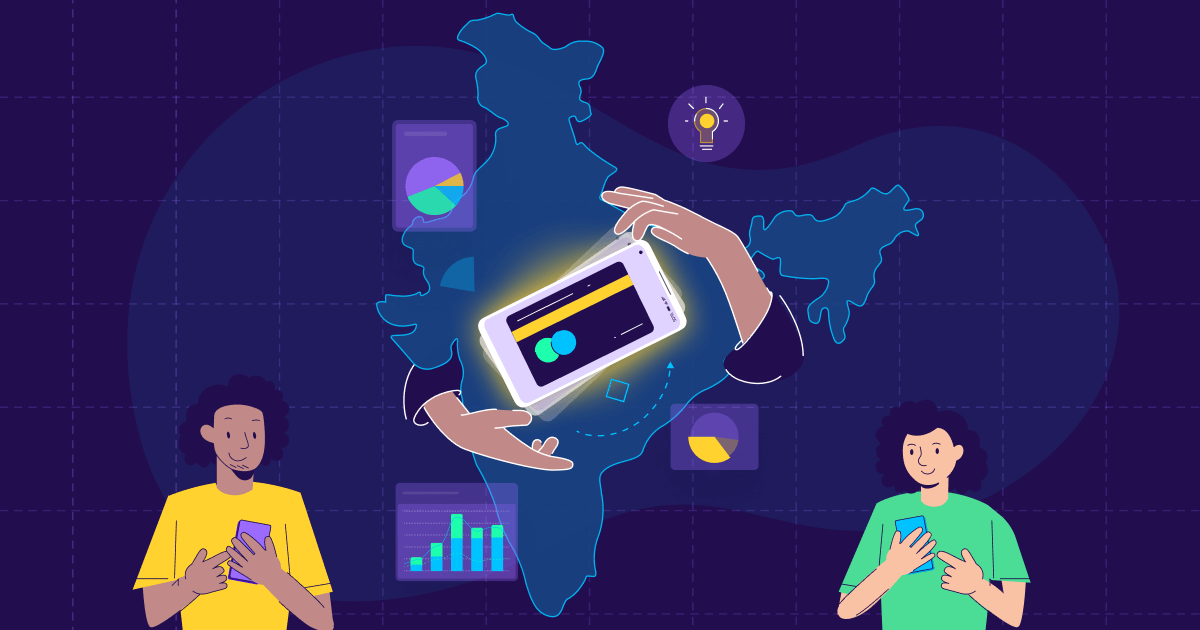
App promotion in APAC – everything you need to know

Mobile users globally downloaded a record 30.3 billion apps in Q2 2019. This massive number does not include the out-of-store installs, re-installs, or app updates, making it all the more impressive.
With as many as 47% of global app downloads happening from the Asia-Pacific (APAC) region (and only 12% from the US), APAC is a natural choice for any app business. This post is intended to help you understand the APAC market better. We will explore the different mobile devices people use, the languages they speak, and try to understand their implications on the user acquisition channels marketers use within APAC.
Given that many brands, which are successful in the West, try to apply the same marketing and user acquisition strategies in APAC and fail, in this post, we will look at the differences in APAC as compared to Western markets.
Android vs iOS and popular device brands
In terms of platform breakdown, 53% of app downloads in the US happen on iOS devices, whereas in APAC, this number is as low as 17%. This is because Asia-Pacific is a big market with a high penetration of budget-friendly Android smartphones, ranging anywhere between USD 75 to USD 150 in countries like India, Indonesia, and China.
As a result of this growth, APAC claims more than 83% of global downloads on Android.
Due to the developing nature of APAC markets, high price sensitivity is also an important factor in the greater diversity of device brands as compared to the West. In the US, Apple (54%) and Samsung (22%) dominate, but in APAC, it is Samsung, along with Chinese manufacturers like Xiaomi, Oppo, and Vivo, which lead the way.
This diversity in device brands and models is an important consideration in how marketers acquire their users, as third-party stores owned by these manufacturers then become an important part of app distribution strategy.
Additionally, most of these devices are low end when it comes to technical specifications and it is important that your app doesn’t consume a lot of storage space and memory for its installation and usage.
[newsletter_form]
Language
The APAC market is fragmented and consists of countries with many ancient cultures, languages, and beliefs.
The strategies which tend to work in the West sometimes don’t apply as much in APAC because of this very reason. Users in APAC are attached to their culture – which means vernacular/regional language-based creatives, ad copy, landing pages, and apps are a must when you begin marketing here.
To put things in perspective, only about 54% of users have their device language set to English, while the remaining 46% only operate in regional languages (Mandarin, Hindi, Bahasa, Vietnamese, Korean, Japanese). Compare this behavior to that of the US, where roughly 70% of mobile devices are set in English and 20% in Spanish.
Whereas covering these two common languages will accommodate 90% of the US market, making your app accessible for the majority of APAC requires more work and greater regional knowledge given the fragmentation of language and culture there.
User acquisition channels
Due to the differences mentioned above, how marketers attract users is also quite different from user acquisition in the Western world. The following are the most common channels more unique to APAC:
- Third party stores. Marketers are not just dependent on the App Store and Play Store; most smartphone manufacturers like Samsung, Xiaomi, Oppo, and Vivo have their own app stores, and many other third-party stores like UC Browser and 9apps also exist.
- Out-of-store. Other out-of-store channels, like ShareIt, tend to be equally popular in the region because mobile internet costs are high and sometimes unaffordable.
- OEM partnerships and pre-install campaigns. Direct partnerships with smartphone manufacturers to have your apps pre-installed from the factory are a great way to drive app downloads and distribution.
Paid media channels vary quite a bit by country, but most advertisers typically start acquiring users with the most popular media sources, seen in the following chart:
| Country | Popular media sources |
|---|---|
| China | Weibo, Baidu, Tencent, Bytedance |
| India & SEA | Facebook, Google |
| Japan | Twitter, Yahoo Japan |
| Korea | Naver |
However, many times, the aforementioned media sources aren’t enough in terms of scale due to limited reach and increasing costs. At this stage, affiliate networks start coming into the picture. While affiliates offer massive scale at significantly lower costs, the major trade-off is that fraud becomes a greater concern.
Especially in developing markets like India and Indonesia, as much as 40% of traffic from affiliates is fraudulent, meaning systems for proactively blocking fraud are a must-have before considering this option.
For a full list of popular media sources, check out our comprehensive global and regional rankings in the AppsFlyer Performance Index.
Outside of traditional and affiliate networks, where else do advertisers turn for user acquisition?
Programmatic
Given APAC’s diversity, marketer savviness with programmatic media buying varies from beginner to, in fewer cases, advanced. Most advertisers, however, are trying to increase the share of wallet diverted towards programmatic media buying, resulting in double-digit growth in this region specifically.
Conversely, due to the massive presence of fraudulent traffic in the region, advertisers are moving away from spending money on affiliates without an anti-fraud solution.
Incentivized campaigns and partnerships
Due to the price-sensitive nature of APAC markets, incentivized campaigns are a great way of gaining new users. Incentives come in various shapes and sizes. You could reward users with discount coupons to drive them to their first purchase, or give them cash back afterwards.
Cross-promoting other brands – for example, a flight booking company sending voucher codes for a taxi booking company – via direct partnerships is another popular acquisition strategy that works well in these markets.
Incentives can also be a part of your owned media strategy in multiple ways. For example, build a referral program which rewards your existing users for bringing friends and family to your app. Another way to integrate incentives in your owned media would be to give a 20% discount to users who install your app after clicking on an app install banner on your mobile site.
Owned media
Being efficient with your media spend is a key outcome for many mobile marketers and owned media helps you do just that. Engaging your users via SMS, email, and push notifications should be a default in your marketing strategy since they do not take away from your advertising budget but are still effective tools for highly personalized engagement.
Users who do not respond to owned media campaigns should be pushed into segments for remarketing via paid media.
Seasonal events and holidays
Since each country within the APAC market has a distinct culture, UA managers should note and capitalize upon the seasonal timing of events and holidays within those relevant. For example, just as China has its own New Year – the Chinese New Year – India celebrates Diwali; Thailand, Songkran; Vietnam, TET; and Indonesia, Ramadan.
Scaling your user acquisition initiatives during festive seasons can result in very high returns, given that the average user spends anywhere between 3 to 10 times their usual monthly amounts.
App categories in APAC
Around the world, people like to play games and APAC is no different. Gaming constitutes the highest number of app downloads in APAC with about 28% of app downloads of the regional install pie. China is home to a number of game development studios, adept at modifying and replicating popular games for APAC markets.
Japanese and Vietnamese gaming studios are also developing equally popular games, striving to reach the same standards as Chinese developers.
Amongst the different Gaming subgenres, Midcore and Casual games have higher chances of success compared to Hardcore. Once again the result of high price sensitivity and the developing nature of the market, these games, which sometimes involve real money, are picking up in the APAC region.
For example, a growing number of studios are building rummy (playing cards game), fantasy sports leagues, and trivia games.
Apart from the larger Gaming vertical, Social, Video & Entertainment, and Shopping apps reign supreme in the region.
While all of these verticals have existed for over 10 years, only a small percentage of the population has been using them consistently. Now, due to greater availability of high-speed mobile internet, many more people are able to download and play heavier games, or stream high-definition music and video on the go, increasing usage of these apps.
To drive further engagement, developers are currently trying to innovate and build more holistic experiences; for example, by incorporating the lyrics of a song in Music and Video apps, or adding live video and/or chat features in Shopping apps.
Working in multiple countries within APAC
Teams
In my opinion, some aspects of app production and marketing need to be driven centrally, while others are better served locally. For example, Engineering & Product are traditionally functions that can more easily be based out of the headquarters. However, business functions, especially those catering to specific regional markets, require both a local and global presence.
As one such business function, marketing critically relies on a local team, which is more knowledgeable about the culture and prospective audience and can make more out of your marketing spend. Hire for a leadership position to build the local strategy, as well as at least 1-2 people to execute that strategy. This usually is a good way to begin.
Having local leadership helps to focus the team on predetermined activities, and avoid unwanted or inappropriate overlap with other regions.
Localization layers
A good place to start in building up the layers of your localization strategy would be to perform an analysis on the language sets for your installed users’ devices. This can help you make a priority list of languages for localization.
To understand if people in specific APAC markets would be interested in your apps, begin by localizing your App Store Pages, Creatives, and Descriptions (i.e. your ASO assets). Additionally, if you are getting support tickets in multiple languages, then try localizing your support by hiring people who can read, write, and speak multiple languages.
Good marketing kills bad products, therefore, localizing the app interface and the product is the last step before you start acquiring users. It is important to understand that localizing the product isn’t just about translating the copy but much larger than that.
For example, a Pokemon game would do very well in Japanese markets but maybe not so well in India whereas a Bahubali (Indian Movie Character) game would garner a lot more interest from users.
User feedback
It’s a human tendency to complain, which means it’s inevitable that negative feedback will surface out quickly on social, via ratings and reviews on stores, and in other digital forums. It is important to properly manage these feedback channels and improve the user experience based on the most realistic comments provided.
On the other side of the coin, people do not often leave positive feedback without an in-app reminder or other prompt to rate/review the app in the store. Let’s look at an example: a user went all the way from a specific product page, where they added the product to their cart, to check out and the final thank you page in just one minute.
This final moment after checkout is the best time to show the user an in-app pop-up to get a rating or review. Incentivizing users through coins, points, or cashbacks is also a nice way to collect feedback.
Closing remarks
With a massive population and low digital penetration, APAC will continue to grow and be an important market for businesses worldwide. Millions of apps will expand their reach to target more users in APAC, competition is going to get fiercer, and user expectations will continue to rise. Due to this, loyalty, retention, and profitability will remain significant challenges for apps.
Even today, a substantial population within emerging markets, like India and Indonesia, is not very comfortable spending money and/or purchasing goods and services online.
Subsequently, the only source of revenue for a majority of apps is ad revenue; however, with less ongoing engagement and less viewed ads, monetization is simply difficult, resulting in significantly lower lifetime value (LTV). Marketers will have to discover new markets, open up new revenue streams, quickly determine quality users, and re-engage them for effective monetization.
Ultimately, at the end of the day, all of this is only possible if we continue to innovate, conduct ongoing experiments, and, most importantly, stay connected to the human element of marketing.




